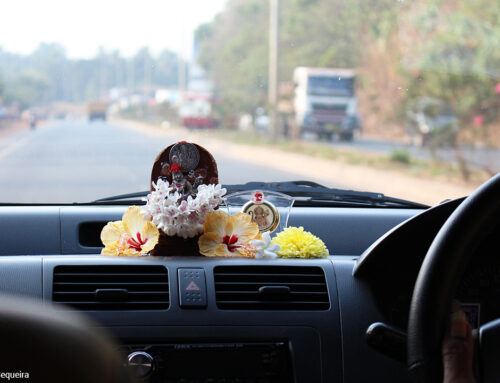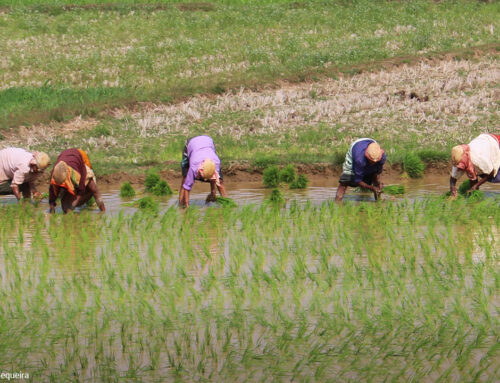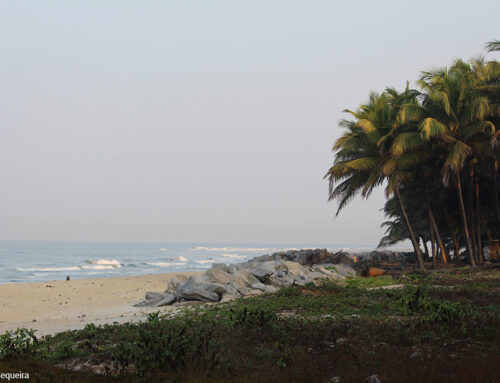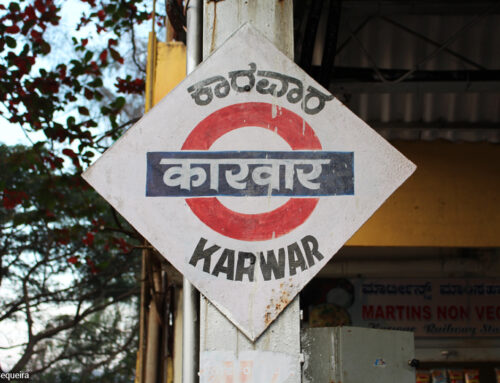“Are you mad?”, exploded my brother, when I told him I was planning a trip to Ratnagiri, my first stop on the Konkan Coast. I understood his concern. For many Goans, Ratnagiri was this remote place that appeared out of the mist, when the Goa – Bombay steamers docked briefly, interrupting the early morning sleep of travellers and revellers. Small boats rowed people onboard ships like the Konkan Shakti or the Konkan Sevak in the pre-dawn dark. Ratnagiri was hardly on a traveller’s radar! So we didn’t know what to expect when our group of four left the Mumbai-Goa highway and veered left, onto Ratnagiri.
A few kilometres along a lonely and dusty road, we were met by a sight I can never forget. Grove upon grove of mango trees, sat in neat rows, hill after hill, filling the landscape on either side of the road. The trees were waiting to explode into the first fruit flowers of the world-famous ‘appus’ – the Alphonso mango -that occupies the unchallenged position as the king of mangoes in India. We had the road, and the dust, all to ourselves, occasionally shared by a lone man or woman, who seemed to be walking to nowhere. For miles, it was just nothingness, except for more mango trees. In mango season, this route would be fragrant with the cloying smell of mangoes. But right now, we seemed to be sailing through miles and miles of greenery tended, it seemed, only by the loving hand of God.
We were hurrying to the coast to get a taste of the cuisine of the northern most part of our Konkan tour. And to visit Ratnagiri’s jewel, Jaigad fort, located at the tip of the peninsula. Gorgeous green gave way to shimmering blue, as we got our first glimpse of the Arabian sea. As we crossed the bridge over the Ganvkhadi creek, we were mesmerised by the beauty of the inlet and the dargah in the middle of it, which can be accessed at low tide. Alan jumped out and got some fabulous shots.
Along the Konkan coast there are at least 20 forts, small and large, and in various degrees of preservation. The fascinating part about these forts is that they were built by a wide variety of rulers from the Islamic Sultanates of Delhi, Ahmednagar and Bijapur to the Nawabs of Murud, the colonial powers of Portugal and Britain and of course, the Marathas. The Jaigad fort stood proud as a Maratha, keeping a watchful eye on its surroundings. Also known as the Fort of Victory, it’s a 16th-century fort, built by the Bijapur sultanate, and sprawled over 13 acres. It changed hands many times before becoming part of the Shivaji domain, and finally being captured by the British. We waltzed in – no ticket required. The fort looked lonely and lost. There was no guide service, no re-telling of history. The Ganesha temple sat in the midst, with a few devotees clustered around. A peep over the fort’s ramparts offers spectacular views of the sea on one side, and a panoramic view of Ratnagiri town on the other. It overlooks a bay created by the tryst of the Shastri river and the Arabian Sea. And a lighthouse sits in solitary splendour at its feet.
Climbing up to the fort and walking along its rambling ramparts made us hungry. We asked around for the restaurant that served the best seafood. Amantran Restaurant got the majority vote. This was a small, yet squeaky clean place buzzing with activity. Hungry hordes were being satiated with efficiency and dexterity as piles of food got conveyed from kitchen to table. My limited Marathi got us access to the super-busy kitchen. 8 chefs and their helpers were preparing fish in every possible way – cutting, chopping, frying and making curries. We had come to Amantran to specifically try their signature dish – Kombdi Vade. Kombdi is chicken in Marathi. This delicious chicken curry is eaten with a special rice-roti called vades. The coconut-based chicken curry was mouth-watering, but what intrigued us was the preparation of the vades. Rice dough is rolled out into a disc. A hole is made in the middle of the disc and then this disc or vade is deep-fried.
Restaurant owners can recognize foodies at a distance. While the vades were being freshly prepared, they made sure the dishes never stopped coming. They insisted on serving us Chinese Fish Soup – Amantran’s specialty. Everybody seemed to be enjoying it – so we did, too. The soul-satisfying soup was followed by a platter of fish so fresh, the huge mound of masala-fried bangda and king fish vanished in no time! The fish curry was irresistibly good, too.
But the piece de resistance was, of course, the Kombdi Vade (checkout for the recipe in the Recipes section). Kombdi Vade is a dish native to the Konkan region of Maharashtra. We poured the luscious chicken curry onto the crisp vades, which greedily soaked up the gravy. Vade after soaked vadde, found 4 hungry mouths that could not get enough of this finger lickin good preparation. We rolled out of Amantran, and sank into the luxury of my brother’s BMW 4 wheel drive, rolling down the windows to enjoy the fresh sea breeze. Truly, sometimes luxury has no limits!
What a great start to our culinary exploration of the perfect curry! If this was how delicious our journey was going to be, I might never leave the Konkan coast!
With that languid thought, I sank deeper into the car seat, smug with the knowledge that dinner was going to be at the next destination renowned for its sumptuous meals: Malvan.
Keep your tastebuds tuned…
For photographs go to the Photo Gallery tab above; likewise for recipes.
Other places to visit in Ratnagiri:
• Ganapatipule Beach
• Jaigad Lighthouse
• Swayambhu Ganapati Temple
• Bhatye Beach
• Kunkeshwar Beach
• Ratnadurga Fort
• Marine Aquarium and Museum
• Purnagad Fort
• Devgad Fort
• Pawas
• Ganapatipule Temple
• Thibaw Palace*
*In 1886, King Thibaw of Burma was sent to Ratnagiri after he was deposed and his country annexed by the British. He would live out the rest of his life as a prisoner in this remote place along with his pregnant wife, his junior queen, and his two young daughters. Ratnagiri was chosen for its location – some 3,000 miles from the former royal seat of Mandalay, accessible only by sea for parts of the year and far from any help that might have reached him.
Best time to visit: November – March
Know your Konkan Coast

The Konkan coast runs south from Mumbai all the way to Kasargod. Quaint fishing villages and magnificent forts look out into the endless blue of the Arabian sea. Pristine beaches and coconut palm trees dot the coast all along, until you reach Malvan, the last beach town of significance, before the sands dissolve into Goa. The cuisine along the Konkan coast is as varied as it is delicious, greatly influenced by its geographic location, and layered history of the region. They are all intertwined yet distinct. Some patterns are common – like the seasons which influenced bottling pickles, and drying of fish and pork etc. The monsoon brought a lot of seasonal foods like bamboo, snails (conge) etc to the table. Coconut is an integral part of the Konkan cuisine. Apart from local influences, Portuguese and Arab influences had major impacts.









Nice blog